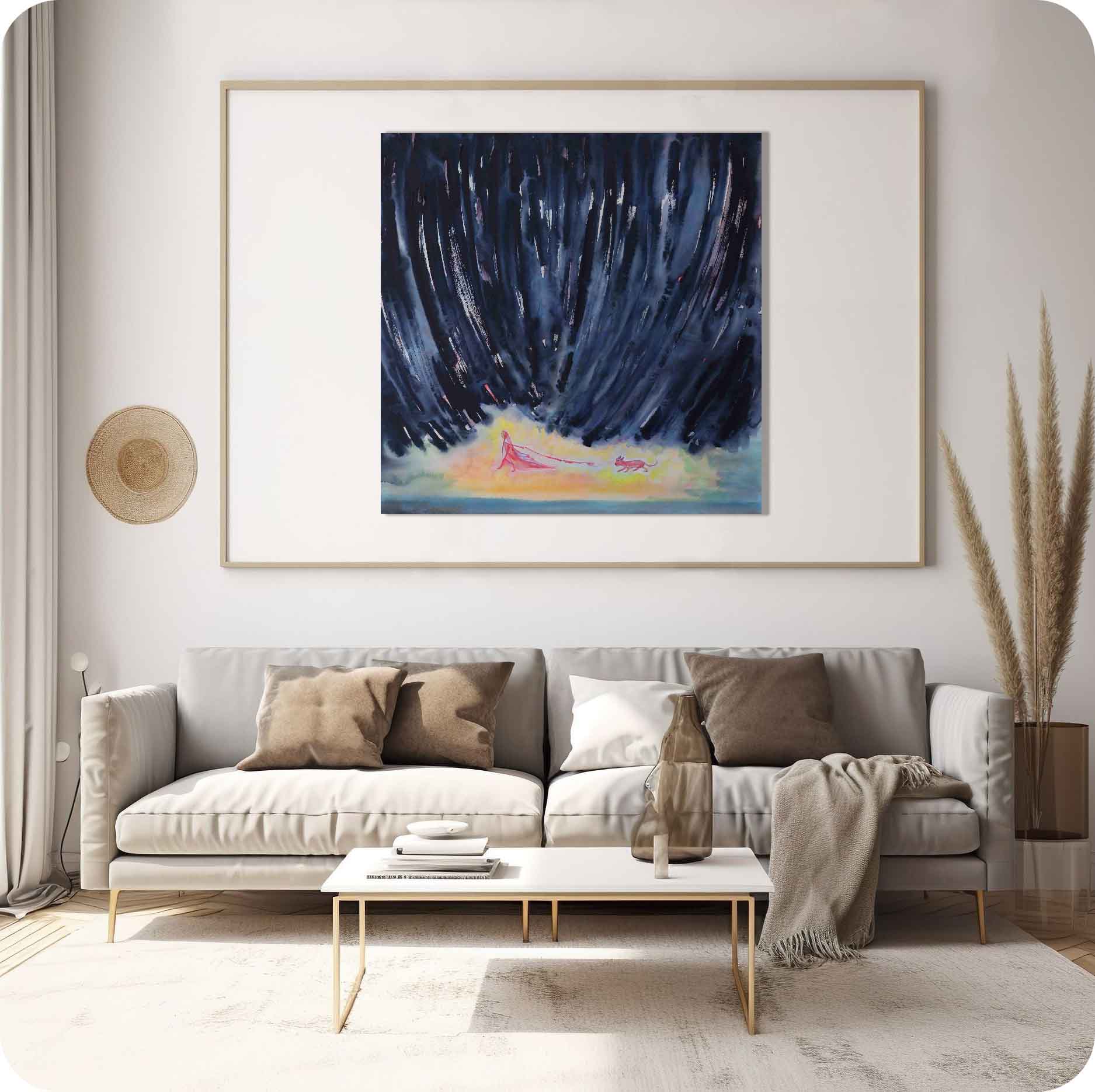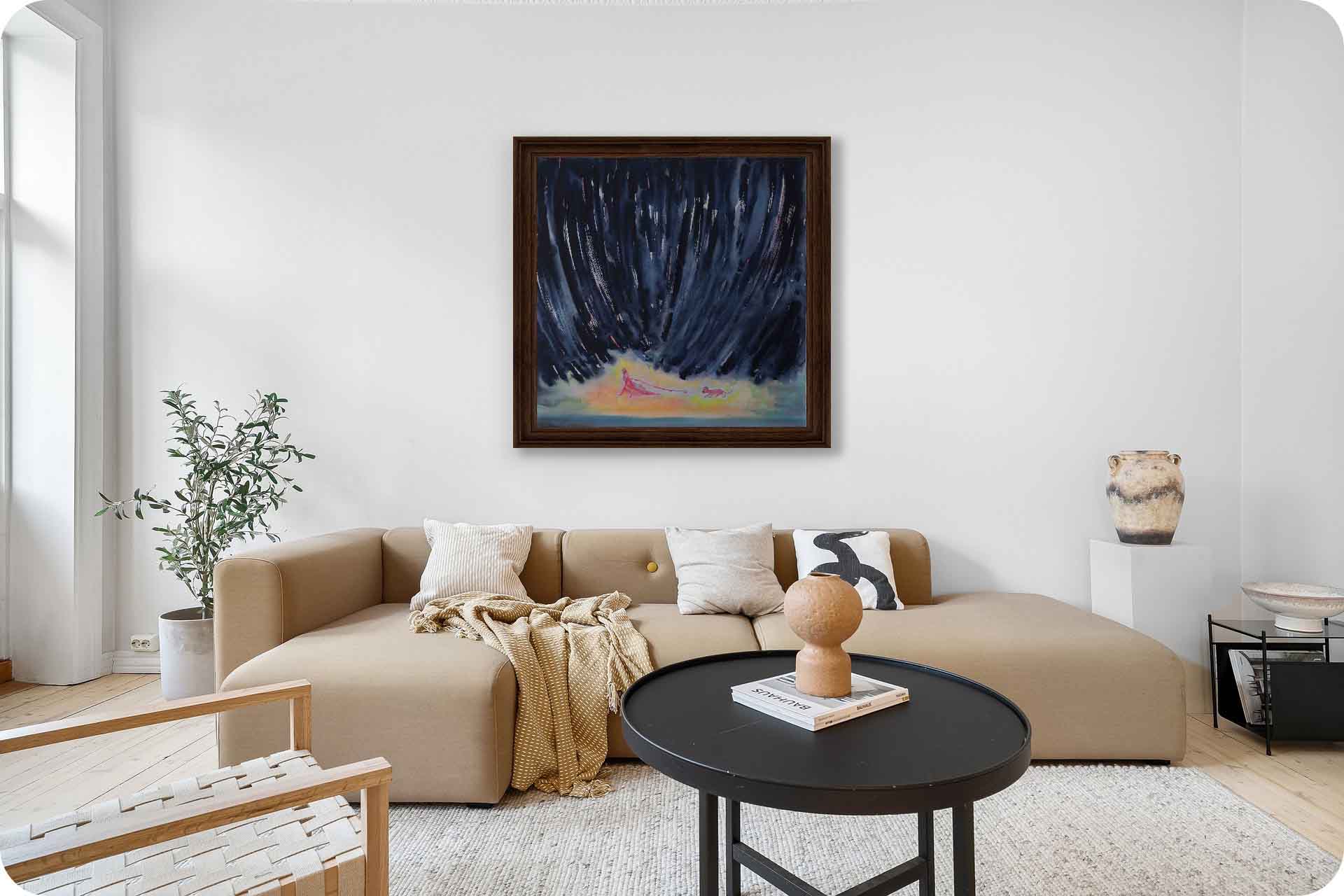The theme of this year's painting clearly states one - the makeup of desire. People's various desires are wrapped under various makeups. Desires are the intertwining of happiness and pain in life. Either straightforward or subtle, they will appear in makeup, forming a profound look of an era.
Inches: 23.6 x 23.6 in
Size without the frame: 60 x 60 cm
Country: China
Date: 2025
Materials: Acrylic Painting on Wood Panel
Condition: well preserved
Creative themes and style | My works revolve around the creative concept of "The land of humanity, People on the land".The people in the painting are people in nature, and the lines, shapes, and colors are close to nature. The nature in the painting is nature in the eyes of humans, existing in interaction with humans.I don’t pursue a series of works with a fixed and continuous style. I hope that the style of the pictures will synchronize with the changes in my life and always remain oscillating. The performance of the work must be in sync with the development of one's own life in order to be Sincere and powerful.Ideas are later.
An Interview with Artist Philo by Artphiloso Gallery
If you would like to collect this artwork or know more about the artist, please contact us.


This acrylic painting constructs a strikingly spiritual and psychological scene. The upper half is filled with cascading, dark brushstrokes, resembling a surging spiritual tide that presses downward with overwhelming force. This imagery may symbolize the weight of life, inner turbulence, or existential uncertainty. In contrast, the lower part of the canvas forms a warm, glowing halo, functioning as a fragile yet powerful refuge against the oppressive darkness above.
At the heart of the illuminated zone stands a red-clad figure accompanied by an animal, likely a dog or cat, rendered in simple yet expressive form. The bond between them, visually reinforced by their shared enclosure within the light, suggests themes of companionship, emotional reliance, and spiritual solidarity. Against the vastness of darkness, these fragile beings embody resilience—the tenacity of individuals seeking light in despair while leaning on each other for strength.
The artist contrasts two distinct modes of expression: the sweeping, almost violent strokes of the dark “tide” above, and the restrained, linear simplicity of the figure and animal below. This juxtaposition heightens the sense of scale between the overwhelming environment and the fragile but persistent presence of life within it. Every brushstroke thus becomes an emotional marker—whether chaotic or serene, it contributes to the visual rhythm of oppression and resistance.
The painting hinges on the contrast between dark and warm tones. The upper section, dominated by heavy blacks and deep blues, conveys a suffocating atmosphere of crisis or spiritual weight. In opposition, the yellow-orange halo radiates warmth and hope, casting the central figures as symbols of life’s enduring spark. This polarity in color not only reinforces the painting’s emotional duality—oppression versus hope—but also embodies the existential struggle between despair and resilience.
There is no traditional perspective; instead, spatial depth is suggested by the vertical descent of the dark tide and the horizontal spread of the luminous ground. This creates a stage-like effect, as though the figures stand within a fragile sanctuary, momentarily shielded from collapse. The atmosphere is therefore both threatening and protective, situating the viewer within a space of spiritual confrontation and reflection.
By integrating overwhelming darkness with a fragile yet persistent pocket of light, the work becomes a metaphor for life’s confrontation with spiritual storms. The figure and animal symbolize the emotional and existential reliance of beings on one another, while their luminous enclosure affirms the power of companionship and the search for hope amid adversity. Ultimately, the painting transcends visual narrative and invites profound contemplation on human resilience, emotional connection, and the eternal search for light within darkness.
Through simple lines and ink washes, Lin constructs an atmospheric scene filled with poetic resonance.
Similarity: Both works employ a minimal set of elements to generate a powerful atmosphere, where simplicity becomes a pathway to deep emotional suggestion.
Wu uses flowing lines and vibrant colors to express the vitality of spring.
Similarity: Both works use expressive lines and color contrasts to externalize inner emotions and to celebrate the vitality of life amidst complexity.
Rousseau’s surreal composition merges fantastical figures and lush settings into a dreamlike vision.
Similarity: Both paintings construct surreal, emotionally charged spaces where reality blends with imagination, inviting reflection on hidden states of being.
Munch employs bold, distorted lines and intense colors to convey existential anxiety.
Similarity:Both works emphasize inner emotional struggle through exaggerated visual language, translating psychological tension into a dramatic visual field.
She walked along the edge of the abandoned playground, the hem of her red dress dragging across the ground and leaving a long trace behind. The sky hung heavy and dim, black clouds pressing so low they seemed ready to collapse at any moment. Beside her, a frail little cat followed closely, each step sinking into the mud without making a sound. The floodlights around the field had long since gone dark, and only the classroom windows in the distance caught and returned the faintest glimmers of light.
Months ago, she had left the city and returned to this desolate town. Every nightfall revealed how lifeless it had become—hardly a single house lit from within, the streetlamps along the roads rusted through and useless. She never quite knew why she came back, or why she stayed, except to keep company with the stray cat. It had followed her home one stormy night and, ever since, refused to leave.
The wind was rising now, the air carrying that damp, biting chill before the rain. She stopped walking, and the cat circled to face her, lifting its head to meet her gaze. She bent down, brushing a hand along its narrow back. Darkness closed in on every side. Only she and the cat remained, wrapped in a fragile circle of faint light.
The large area of dark vertical strokes at the top cascades like a waterfall, creating a sense of pressure and vastness. This makes the figures and animals at the bottom appear small yet resilient, highlighting the emotional tension of “loneliness and guardianship.”
The figure is drawn with minimalist lines, almost swallowed by darkness, but the small cat beside it is also painted in red, symbolizing companionship and warmth. The red tone not only represents vitality, but also creates a strong emotional contrast with the surrounding black.
Through the minimalist red figure and animal, combined with the abstract background treatment, the work generates a strong sense of storytelling and spatial tension. This makes it perfectly aligned with the art e-commerce market category of “contemporary minimalist narrative decorative painting.”
Its unique combination of figure animal abstract background is relatively rare in the art e-commerce scene. In particular, the glowing halo effect emerging from the dark background makes it highly appealing as a “home ambiance decorative artwork.”
The figure and the cat are connected through the same color palette, set against the contrast of darkness and light, creating a powerful sense of companionship. This makes it especially fitting as an “emotional companionship themed abstract artwork”, ideal for both gifting and collecting.
A: Click here to view ARTPHILOSO's Guide for Collectors.
More paintings from this series:
The makeup of desire 1 The makeup of desire 2 The makeup of desire 3 The makeup of desire 5
The makeup of desire 7 The makeup of desire 8 The makeup of desire 9
The makeup of desire 11 The makeup of desire 12 The makeup of desire 13 The makeup of desire 14
The makeup of desire 15 The makeup of desire 16 The makeup of desire 17
